21 Things You Didn't Know You Could Clean with Rubbing Alcohol
This medicine cabinet staple is so multipurpose, you're probably not using it to its full potential.
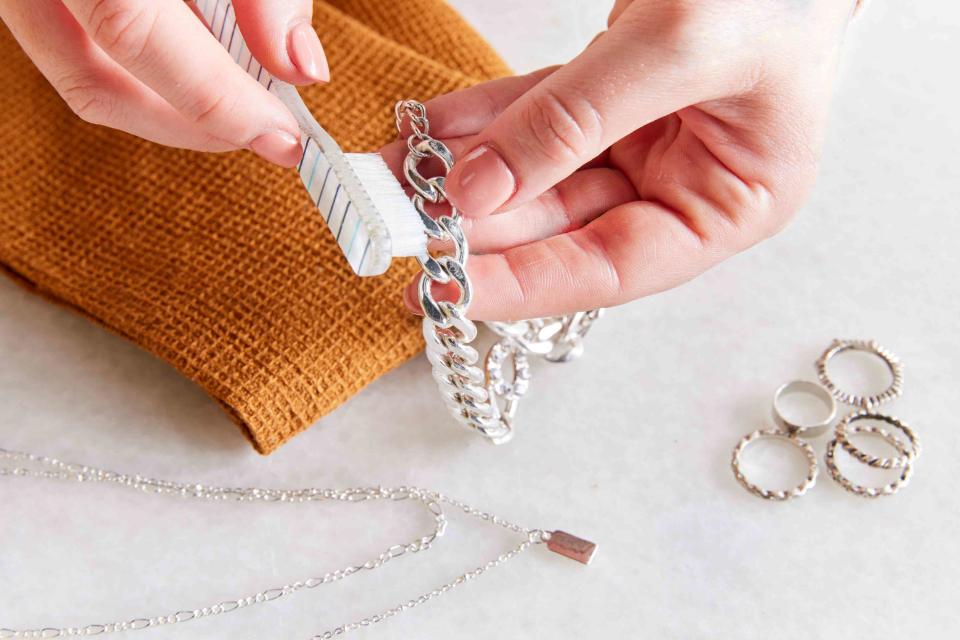
Jason Donnelly
A bottle of isopropyl alcohol—more commonly known as rubbing alcohol—is inexpensive, widely available, and is probably sitting on a shelf in your home as we speak. If not, we strongly suggest adding it to your shopping list. This miracle liquid, comprised of 70% alcohol and 30% purified water, is the solution for countless bodily ailments and household messes thanks to its antiseptic and disinfectant properties.
You might already be using rubbing alcohol as a natural cleaner, but chances are there are a few things you didn't know you could clean with it. From removing permanent marker from over a dozen surfaces to getting red wine out of multiple types of fabric and flooring, there’s little this homemade cleaner can’t handle.
Save this guide of things you can clean with rubbing alcohol for the next time you find yourself up against a stubborn stain or sticky situation.
Related: Does Vinegar Kill Germs? An Expert Discusses Homemade Cleaners
Rubbing Alcohol Cleaning Safety Tips
Before you bust out the bottle of rubbing alcohol, take note of these safety guidelines to avoid causing unintentional harm. Keep these essential protocols in mind as you get ready to tackle (almost) every dirty surface in your home.
Never mix with rubbing alcohol with bleach. Combined, the two with create chloroform which is toxic for humans to inhale.
Never use rubbing alcohol near a flame as it’s a highly flammable substance. Blow out candles before opening the bottle and keep it away from heat sources.
Always use rubbing alcohol in a well-ventilated area. Open windows and turn on fans if possible.
Always keep rubbing alcohol out of the reach of children and pets.
Always research if a questionable material or surface can be cleaned with rubbing alcohol before potentially damaging your belongings. It’s also a good idea to test it on a small, inconspicuous area, even if it’s deemed safe to use on that particular item.
Never ingest rubbing alcohol, even in small amounts. Even if you’re cleaning a wound with it, only use it sparingly, as absorbing too much into the skin can become dangerous.
Related: How to Safely Store Cleaning Supplies
1. Stainless Steel
Easily remove water spots, smudges, and finger prints from stainless steel by dampening a microfiber cloth with rubbing alcohol and wiping appliances or sinks (in the direction of the grain) with it. Your refrigerator, microwave, and dishwasher door can be sparkling again in minutes, even after your kids have been rubbing their hands all over them. Rubbing alcohol can even be used to remove lipstick and ink from a steel dryer drum.
Related: The Best Methods to Cleaning Appliances, Step by Step
2. Chrome
Follow the same procedure for removing smudges and spots from chrome fixtures and furniture details. Rubbing alcohol will evaporate, so there’s no need to rinse after wiping faucets, for example. It simply breaks down the mineral deposits that create hard water stains in the blink of an eye.
Related: Get Ready for Chrome to Take Over the Home In 2024
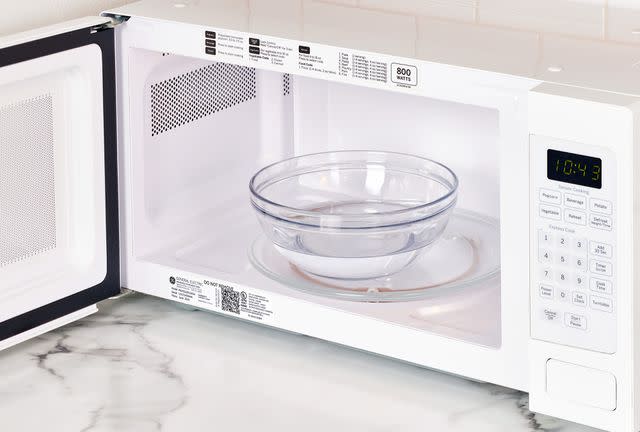
Brie Goldman
3. Microwave Interior
Forgot to cover your leftover pasta in the microwave? There’s no need to stress about scrubbing it. Try adding equal parts rubbing alcohol and water into a microwave-safe bowl and heat it for a minute or two. Let it cool for a bit, dip a microfiber cloth in the liquid, and use it to wipe the interior of the microwave. The steam created from the mixture will have loosened the food, making it much easier to remove.
Related: The 8 Best Oven Cleaners of 2024 Will Leave Your Appliance Sparkling Like New
4. Sponges
There are a variety of ways to clean and disinfect a kitchen sponge. But one quick strategy is to soak it in rubbing alcohol weekly so you can extend its life. Place it in a small food storage container, pour enough alcohol to cover it, and then close the lid if you’d like. Leave the sponge soaking for an hour or so before ringing it out and using it again like new.
5. Grease and Grime
Speaking of sponges, they’re often used to tackle grease found on kitchen surfaces. Grab a bowl, fill it with 50% hot water and 50% rubbing alcohol, and then dip a clean sponge in the solution. The alcohol will make it easier to scrub greasy spots on the stove, backsplash, cabinets, and even small appliances. Once satisfied that it’s gone, dampen a second clean sponge with warm water to rinse before wiping the area dry with a soft towel.
Related: How to Clean Your Range Hood Filter to Prevent Grease Clogs
6. Countertops and Other Surfaces
Since it’s a disinfectant, rubbing alcohol is an inexpensive way to keep your home germ-free, especially during cold and flu season. Rub countertops, doorknobs, light switches, handles, and anything else you touch on a daily basis with a cloth soaked in alcohol. It’s important to not dilute rubbing alcohol when using it as a disinfectant specifically as that will reduce its effectiveness. Avoid using it on quartz, wood, acrylic, and anything painted, stained, lacquered, or shellacked as it can damage these surfaces.
Related: How to Clean Kitchen Countertops—Our Best Tricks for Any Material
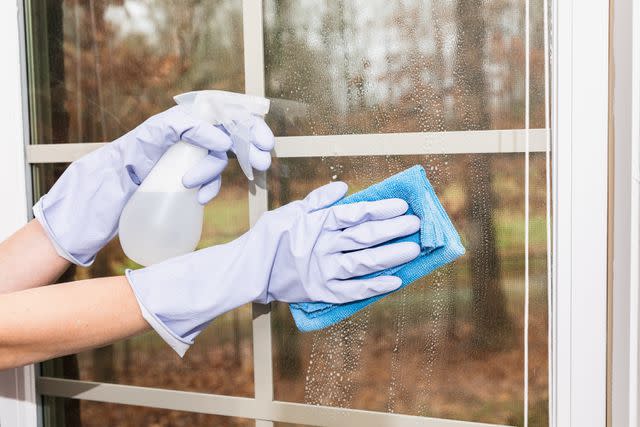
BHG / Ana Cadena
7. Glass and Mirrors
Save money and make a DIY window cleaner by mixing rubbing alcohol with water (and a small amount of white vinegar if you’d like) into a spray bottle. Shake it to combine ingredients and spray on glass surfaces, like windows or tabletops, and mirrors around the house for a streak-free shine. It’s an excellent way to remove hairspray and toothpaste that splatters on bathroom mirrors, as well as, marker residue from the dry-erase boards in your command center or office.
Related: How to Clean Windows Inside and Out for Streak-Free Results
8. Chandeliers
Cleaning a chandelier is a tricky task no matter what you use to complete it. But you can keep supplies inexpensive by relying on rubbing alcohol. Fill a spray bottle with one part alcohol and four parts distilled water and then spray a soft cloth with the mixture. While wearing cotton gloves to prevent fingerprints, carefully wipe down individual pieces of the chandelier to remove dirt and debris.
9. Blinds
Perhaps even more tedious to tackle than a chandelier, cleaning window blinds can be done using a variety of products, including rubbing alcohol. Soak a cloth in it and then wrap it around a duster brush with sleeves or, if you don’t have one, a kitchen spatula or set of tongs. Run whatever you use in between each slat until they’re dust-free.
10. Upholstery and Carpet
Getting a stain out of a microfiber couch or the carpet is not as challenging as it may seem once you employ rubbing alcohol. Spray alcohol directly on stains and then immediately use a light-colored sponge or soft-bristled brush to scrub it out. Once it’s disappeared, any dampness should also dissipate quickly. Then, you can use a dry brush in a circular motion to re-fluff the fabric. Rubbing alcohol can also be used to remove stubborn, sticky items, like candle wax or tree sap, or fatty stains, like butter, from the carpet. Refrain from using it on wool, rayon, and silk as it can discolor or fade these fibers.
Related: How to Clean Upholstered Furniture to Keep It Looking Spotless
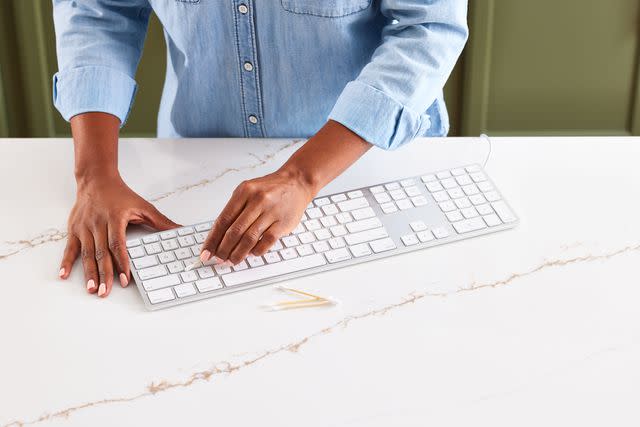
Brie Goldman
11. Electronics
Rubbing alcohol is a powerful match against dirty cellphones, tablets, headphones, controllers, keyboards, and your computer mouse. Think about how many times a day you touch these items, or bring them (namely your phone) into the bathroom with you. Not only do they collect bacteria and germs quickly, but also dirt, oil, makeup, and even food particles build up quickly. While you should never spray rubbing alcohol directly onto your devices, you can disinfect them by dampening a lint-free cloth in it and running it along surfaces, being careful not to get it in any open ports or speakers. An alcohol-dipped cotton swab is a great way to get into crevices, such as between keys on your keyboard.
Related: Why Coffee Filters Are the Secret to Keeping Your Electronics Dust-Free
12. Flooring Spills and Scuffs
Did you recently spill paint on the hardwood floors? Mix a small amount of rubbing alcohol with lemon juice, dip a cloth in the solution, and let it sit on top of the paint for a few minutes. You should be able to scrape it off with a putty knife without damaging the flooring. Additionally, you can use rubbing alcohol to remove ink or crayon scuffs, shoe polish, and nail polish (mix it with a little nail polish remover) from laminate floors.
Related: How to Clean Hardwood Floors for a Polished Look
13. Houseplants
If you’ve noticed a small infestation of scale insects, including mealybugs, on your precious plants, soak a cotton swab in rubbing alcohol and apply it to the affected areas. It will kill the bugs but not your plant.
Related: How to Clean Your Houseplants to Get Rid of Dust and Pests
14. Sticker Residue
Peeling labels or stickers off of products (or surfaces your kids decided to decorate with stickers) can be a pain, but rubbing alcohol alleviates some of the manual elbow grease. Remove sticker residue by saturating it with alcohol, letting it sit for a little bit, and then wiping it away effortlessly.
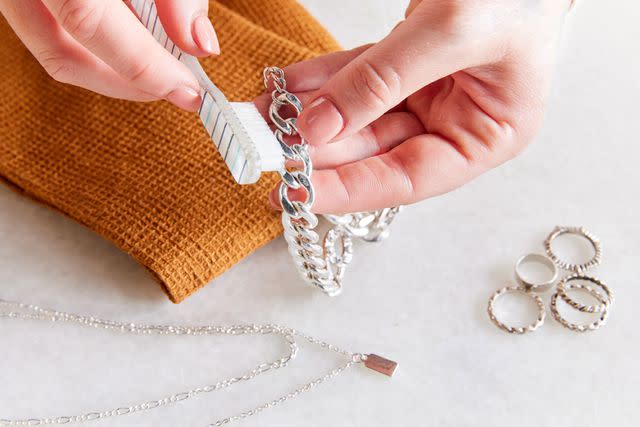
Jason Donnelly
15. Jewelry and Silver
There's no need to invest in a fancy cleaner when you can clean jewelry using household ingredients. Fill a bowl with rubbing alcohol, submerge your lackluster pieces in it, and allow them to soak overnight. Use a cloth, cotton swab, or clean toothbrush to gently rub away any lingering debris, and then briefly dip them in a clean bowl of alcohol before letting them air dry. Note that this approach should only be used on jewelry made of silver (including sterling and platinum), gold, and most gemstones. Costume jewelry, including pieces made of plastic, copper, pearls, or opals should not be cleaned with alcohol as it can corrode these materials.
Related: How to Clean Silver Jewelry in a Matter of Minutes
16. Clothing
Much like it can remove acrylic paint and ink stains from floors, rubbing alcohol can also get them out of garments. Simply soak the affected area with alcohol, let it work its magic for a few minutes, and either blot it (with an old towel underneath to protect surfaces) or toss the article in the wash. Sat on some gum? Apply rubbing alcohol to the wad, wait until it dries, and then use a piece of duct tape to peel the gum right off.
Related: 11 Genius Guaranteed Methods for How to Get Gum Out of Clothes
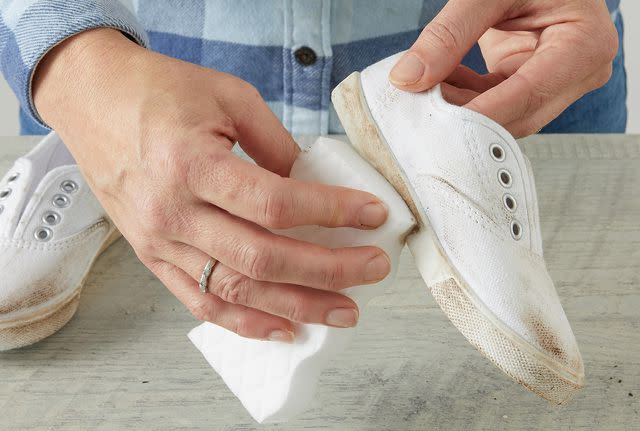
17. Shoes
You probably know of a few different methods to use to clean shoes. But what about deodorizing them? If your well-worn sneakers are starting to smell a little offensive, spray the insoles of them with rubbing alcohol and let them dry before putting them back on. Leaving them in the sun for a bit can speed up the process.
18. Skincare Tools, First Aid Supplies, and Makeup Brushes
Disinfect the things you use on your skin and nails, like tweezers, cuticle cutters, and thermometers (avoiding the sensors), by wiping them down with rubbing alcohol. Dip makeup brushes into a bowl of alcohol, swirl them around a few times, and then rinse and lay them flat to dry.
Related: How to Clean Makeup Brushes and Sponges
19. Car Interiors
Another place that gets handled with dirty hands frequently is the interior of your car. Scrub the steering wheel, gear shift, and handles with a microfiber cloth dampened with rubbing alcohol to sanitize these surfaces. As for the exterior, forget scraping ice on freezing winter mornings. Instead, combine two parts rubbing alcohol and one part water in a bottle and spray on the windshield for easier frost removal. Or get sap off of the outside of your car by carefully rubbing it with a soft cloth soaked in alcohol.
Related: Your Car Is Even Dirtier Than a Toilet Seat—Here's How to Disinfect It
20. Bedbugs and Fruit Flies
You’re already aware that rubbing alcohol can eliminate insects found in plants. But it’s helpful to know that it can also be used in the fight against two other pesky household pests, too. While a major bedbug infestation is usually best handled by an exterminator, you can nip a minor one in the bud by spraying the afflicted areas with rubbing alcohol which will kill the bugs and their eggs on contact. Getting rid of fruit flies can be done utilizing several DIY methods, one of which is by spritzing them with rubbing alcohol. Like bedbugs, it will also kill them immediately and it’s advised to move fruit out of the way before spraying the area.
21. The Air
You can sweeten the smell in your home by concocting a custom room freshener. In a spray bottle, combine three parts water, one part rubbing alcohol, and a dozen or so drops of your favorite essential oil (being mindful of which ones are safe for pets if you have them in the house). Shake it up and spray to your heart’s content.
Related: 7 Natural Ways to Eliminate Odors and Make Your Home Smell Amazing
For more Better Homes & Gardens news, make sure to sign up for our newsletter!
Read the original article on Better Homes & Gardens.

